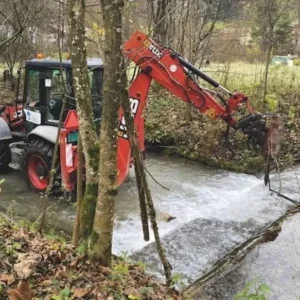
Like any other industry, when the topic of automation in oil and gas crops up it comes laden with promises of accelerated processes and safe work environments, in addition to more than a few concerns over job security.
It’s been slowly making its way into the sector since the early 1990s and has contributed to debunking the idea that oil and gas professionals live a dangerous life – in fact, those working on offshore rigs now have a lower injury rate than teachers.
And yet, issues remain over whether or not automating jobs in the industry is going to exacerbate its skills crisis, which isn’t a myth and warrants serious attention, according to The Global Energy Talent Index (GETI).
This is not to mention the potential for widespread job losses – a bone of contention posed by automation in virtually every industry embracing it.
Here we gather the thoughts of various industry professionals in order to identify the benefits of automation in oil and gas, as well as to measure the full weight of its consequences and how to deal with them.
Oil and gas automation: Pros
Peter Maier, co-president of industries at multinational software corporation SAP
In this complex energy market, the oil and gas industry is facing new challenges as it transitions to more efficient operations and lower carbon business models.
Those in the sector understand that 80% of what they do is non-differentiating and they are looking for market-based standard solutions to automate these business functions.
This allows the companies to focus on the 20% of their businesses that is differentiating and increase their efficiency.

Automation technology can create efficiencies that make both environmental and financial sense as opportunities exist from the wellhead to the petrol pump, across the full oil and gas lifecycle.
For example, automation of drilling operations using continuous diagnostics based on sensor data from the drilling equipment will increase accuracy, reduce cost, increase uptime and improve safety.
Automation also has the capability to optimise supply chains, workforce deployment, spare parts management and numerous organisational inefficiencies.
Mike Price, director at research and development tax credit specialist MPA Group
The process of automating factories began a long time ago, but in recent years the technology has developed to such a level that it is becoming ubiquitous in industry.
It’s only natural that oil and gas companies will incorporate it into their business models, as if deployed smartly, automated machines can both improve existing supply chains and provide new opportunities.
The real surge in interest from oil and gas companies in automation came during the dramatic downturn between 2014 and 2016, with rapidly falling prices forcing budget changes.
Automation can be used to cut staff costs and thus prompted a rush of investment.

Aside from the financial implications, there are also significant safety benefits to automation, with machinery able to take the place of humans in the more dangerous areas of work.
Within the oil and gas industry, automation can be used to improve a variety of processes, from boiler diagnostics to the actual drilling.
Data analysis is also incredibly compatible with automated technology, with machines capable of gathering and assessing large swathes of information at speeds far beyond human ability.
James Woodall, CTO at tech firm Intoware
It’s important to recognise that the oil and gas sector is inherently innovative.
The development of automation and mobile technology progress in areas such as control systems, sensors, and big data has been impressive.
Many offshore and onshore drilling organisations have already digitised many processes in efforts to cut costs and reduce danger levels.
However, it remains an industry that still relies on many paper-based processes.
This may seem insignificant compared to some of the bigger challenges the sector is facing, but when you scale the problem across millions of work processes and hundreds of thousands of workers, even small efficiencies become massive benefits.
Aside from just the time saved, the digitalisation of paper-based processes allows companies to harness invaluable data and insight that is often completely lost.

It is easy to overlook work instructions and digital processes as simply a hygiene factor, but the benefits technology adoption in this area can offer are vast.
Even something as simple as transforming physical manuals and documentation into digital documentation can yield impressive results.
Replace paper checklists and manuals with a tablet or IS device, and you have the ability to capture a wealth of data in real-time.
Photos, video and data can be captured and time-stamped, adding valuable context and data to, for example, a regular inspection process.
Compliance and audits are also obvious candidates for digitalisation.
Digital work instruction technologies save a system of record so everyone can see who approved what and when, allowing for faster approvals, handovers and compliance checks.
There are literally thousands of documents created in upstream oil and gas operations, from lease agreements and partner contracts to run tickets, purchaser statements and transaction reports.
Back in the office, data visualisation tools can turn this wealth of data into powerful insights, identifying bottlenecks and problems that simply can’t be captured on paper.
New processes can be created and deployed across a global workforce in minutes, and complex documentation can be turned into step-by-step processes that create an alert if they are not followed correctly.
The potential usage cases really are endless.
Oil and gas automation – Cons (and what to do about them)
Danny Powell, divisional manager for oil and gas at global recruitment specialist Samuel Knight International
While there are clearly many benefits to the advancement in technology, this growth is also adding strain to the chronic skills issue that is already being noted in this field.
The long-running STEM skills shortages has certainly limited the availability of industry-specific resources in the oil and gas field.
However, technology can help improve this situation by eradicating many time-consuming aspects of multiple roles – ultimately freeing up niche skill sets and reducing some of the resourcing challenges.
AI will also play an important role in preserving the expertise and knowledge of the ageing workforce, further ensuring skills aren’t lost as the industry reaches a retirement cliff.

Peter Maier, co-president of industries at multinational software corporation SAP
Automation in oil and gas creates opportunities for workers with the right skills – both dangerous and repetitive work will be the focus of much automation.
In the light of skills shortages and increasing energy demand, we expect stability in the petrotechnical professional workforce.
Administrative jobs are a different matter: automation of business processes based on machine learning and advanced analytics will fundamentally change or eliminate many jobs that are based on formalised and repetitive tasks.
Overall we anticipate considerable automation-driven transformation of many if not most business, operations and work processes.
Mike Price, director at research and development tax credit specialist MPA Group
There are a few drawbacks to oil and gas companies investing in automation, primarily to do with people and logistics.
Incorporating these new technologies into a supply chain can come at a hefty cost and can require major redevelopment of business models.
There’s also the obvious and much-discussed danger of automation replacing jobs.
The fear that technology will replace humans in workplaces has been around for a long time and while automation does have the potential to take over some processes within supply chains, in the foreseeable future it’s unlikely to completely render existing workers redundant.
In fact, technology could actually benefit a workforce as it often takes on the more mundane and manual tasks, leaving staff to focus on more skilled activities.
Furthermore, wherever automated machines are deployed, humans are going to be needed to maintain the technology and ensure they’re running efficiently.
Human judgement is an incredibly valuable skill which technology is not yet able to effectively replicate.
Until that day, entrepreneurs would be wise to maintain investment in staff, while embracing the new opportunities which automation brings.






